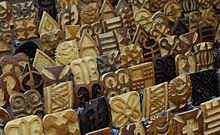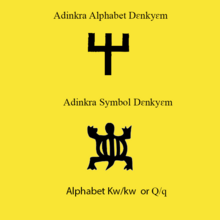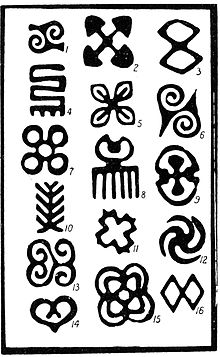Adinkra are symbols from Ghana that represent concepts or aphorisms. Adinkra are used extensively in fabrics, logos and pottery. They are incorporated into walls and other architectural features. Adinkra symbols appear on some traditional Akan goldweights. The symbols are also carved on stools for domestic and ritual use. Tourism has led to new departures in the use of symbols in items such as T-shirts and jewellery.


The symbols have a decorative function but also represent objects that encapsulate evocative messages conveying traditional wisdom, aspects of life, or the environment. There are many symbols with distinct meanings, often linked with proverbs. In the words of Kwame Anthony Appiah, they were one of the means for "supporting the transmission of a complex and nuanced body of practice and belief".[1]
History edit

Adinkra symbols were originally created by the Bono people of Gyaman. The Gyaman king, Nana Kwadwo Agyemang Adinkra, originally created or designed these symbols, naming it after himself. The Adinkra symbols were largely used on pottery, stools etc. by the people of Bono. Adinkra cloth was worn by the king of Gyaman, and its usage spread from Bono Gyaman to Asante and other Akan kingdoms following its defeat. It is said that the guild designers who designed this cloth for the Kings were forced to teach the Asantes the craft. Gyaman king Nana Kwadwo Agyemang Adinkra's first son, Apau, who was said to be well versed in the Adinkra craft, was forced to teach more about Adinkra cloths. Oral accounts have attested to the fact that Adinkra Apau taught the process to a man named Kwaku Dwaku in a town near Kumasi.[2][3][4][5][6][7] Over time, all Akan people including the Fante, Akuapem and Akyem all made Adinkra symbols a major part of their culture, as they all originated from the ancient Bono Kingdom.
The oldest surviving adinkra cloth was made in 1817. The cloth features 15 stamped symbols, including nsroma (stars), dono ntoasuo (double Dono drums), and diamonds. The patterns were printed using carved calabash stamps and a vegetable-based dye. It has resided in the British Museum since 1818, when it was donated by Thomas E. Bowdich.[8][9][10]

The next oldest piece of adinkra textile was sent in 1825 from the Elmina Castle to the royal cabinet of curiosities in The Hague, in response to an assignment from Major Friedrich Last, who was appointed temporary Commander of Dutch Gold Coast. He had the cloth commissioned from the Fante paramount chief of Elmina for William I of the Netherlands, which would explain why the coat of arms of the Netherlands is in the centre. The other motifs are typical of the older adinkras. It is now on display in the National Museum of Ethnology in Leiden.[11]
In November 2020, a school board in York, Pennsylvania, banned "a children's coloring book that featured African Adrinkra [sic] symbols found in fabrics, logos and pottery."[12] The decision was subsequently overturned.[13]
Adinkra cloth edit
In Akan (Twi), the term adinkra refers to not symbols, but a particular type of cloth.[14][15] Adinkra cloths were traditionally only worn by royalty and spiritual leaders for funerals and other very special occasions. In the past they were hand-printed on undyed, red, dark brown or black hand-woven natural cotton fabric depending on the occasion and the wearer's role; nowadays they are frequently mass-produced on brighter coloured fabrics.[16]


The present centre of traditional production of adinkra cloth is from Ghana, Ntɔnso, 20 km northwest of Kumasi and in Ivory Coast.[17] Dark Adinkra aduro pigment for the stamping is made there, by soaking, pulverizing, and boiling the inner bark and roots of the badie tree (Bridelia ferruginea)[18] in water over a wood fire. Once the dark colour is released, the mixture is strained, and then boiled for several more hours until it thickens. The stamps are carved out of the bottom of a calabash piece. They measure between five and eight centimetres square. They have a handle on the back, and the stamp itself is slightly curved so that the dye can be put on with a rocking motion.
Adinkra Alphabet edit
Adinkra Alphabet is a phonetic writing system derived from Adinkra symbols. The Adinkra Alphabet, invented by Charles Korankye in 2015, and expanded and refined over the next several years to accommodate various languages spoken in Ghana and Ivory Coast such as Akan, Dagbani, Ewe and Ga- a process that culminated with the creation of a standardized font in 2020.



Sample of symbols listed edit
Recorded sample of 53 adinkra symbols and their meanings

| Number | Symbol Name | Literal Meaning | Further Details | Related Symbols | |
|---|---|---|---|---|---|
| 1 | Aban | a two-storied house, a castle | this design was formerly worn by the King of Gyaman alone | ||
| 4 | Adinkira 'hene | the Adinkira king | 'chief' of all these Adinkira designs | ||
| 8 | Agyindawuru | the agyin tree's gong | the juice of a tree of that name is sometimes squeezed into a gong and is said to make the sound pleasing to the spirits | ||
| Akam | an edible plant, possibly a yam | ||||
| 9 | Akoben | the war-horn | |||
| 12 | Akoko nan tia 'ba, na nkum 'ba | A hen treads upon chickens but does not kill them | |||
| 13 | Akoma | a heart, with a cross in the centre | |||
| [None listed] | No. 13 | ||||
| 14 | AKOMA NTOSO | the joined hearts | |||
| 18 | Aya | the fern | the word also means 'I am not afraid of you', 'I am independent of you' and the wearer may imply this by wearing it | ||
| 20 | BI NKA BI | no one should bite the other | |||
| 23 | DAME-DAME | name of a board game | symbol of intelligence and ingenuity | ||
| 25 | Dono | the dono drum | |||
| 26 | Dono ntoasuo | the double dono drums | |||
| 27 | Duafe | the wooden comb | |||
| 28 | Dwenini aben | the ram's horns | |||
| 30 | Epa | handcuffs | |||
| 34 | Fihankra | the circular house | |||
| 35 | Se die fofoo pe, ne se gyinantwi abo bedie | what the yellow-flowered fofoo plant wants is that the gyinantwi seeds should turn black | A Bono saying. One of the cotton cloth designs bears the same name. The fofoo, the botanical name of which is Bidens pilosa, has a small yellow flower, which, when it drops its petals, turns into a black spiky seed. Said of a jealous person. According to Ayensu (1978), the gyinantwi also refers to Bidens pilosa.[19] | ||
| 37 | Funtunfunefu Denkyemfunefu | Siamese crocodiles | They share one stomach yet they fight over food | ||
| 38 | Gyawu Atiko | the back of Gyawu's head | Gyawu was a sub-chief of Gyaman who at the Adae Kesse ceremony is said to have had his hair shaved in this fashion | ||
| 39 | Gye Nyame | 'Except God' or 'Only God' | |||
| 41 | Hye wo nhye | He who would burn you be not burned | |||
| 44 | Kojo Biaden | ||||
| 47 | Papani amma yenhu Kramo | The (large number of) people who do good prevents us knowing who really are Mohammedans | as adherents of Islam are enjoined to do good works in the community, and increasing numbers of non-Muslims are also doing so, we can no longer use that criterion to distinguish those Muslims living amongst us | ||
| 49 | Kuntinkantan | bent and spread out | kuntinkantan is used in the sense of 'do not boast, do not be arrogant' | ||
| 50 | [None Listed] | copied from Europeans | |||
| Non listed | Kwatakye atiko | at the back of Kwatakye's head | Kwatakye was a war captain of one of the Gyaman kings; at the Adae Kesse ceremony he is said to have cut his hair after this fashion | ||
| Non listed | Mmrafo ani ase | the keloids on a Hausa man | |||
| 55 | Mmra Krado | the Hausa man's lock | |||
| 56 | Musuyidie | something to remove evil | a cloth with this design stamped upon it lay beside the sleeping couch of the King of Gyaman, and every morning when he rose he placed his left foot upon it three times | ||
| 58 | Mpuannum | five tufts (of hair) | |||
| 62 | Nkonsonkonson | links of a chain | |||
| 63 | Nkotimsefuopua | certain attendants on the Queen Mother who dressed their hair in this fashion. Similar to a swastika. | |||
| 66 | Nkyimkyim | the twisted pattern | |||
| 68 | Nsaa | from a design of this name found on nsa cloths | |||
| 69 | Nsirewa | cowries | |||
| 70 | Nsoroma / Nsoromma | a child of the Sky / Child of the Heavens | referring to the saying: Oba Nyankon soroma te Nyame so na onte ne ho so, 'Like the star, the child of the Supreme Being, I rest with God and do not depend upon myself.' / the pattern was on the King of Gyaman's pillow | ||
| 71 | Ma te; Masie | I have heard (what you have said); I have hidden it | this extols the virtue of being able to keep a confidence | ||
| Non listed | Nyame, biribi wo soro, ma no me ka me nsa | O God, everything which is above, permit my hand to touch it | the pattern was stamped on paper and hung above the lintel of a door in the palace. The King of Gyaman used to touch lintel, then his forehead, then his breast, repeating these words three times | ||
| 74 | Nyame dua | an altar to the Sky God | |||
| 76 | Nyame nwu na ma wu | May Nyame die before I die | |||
| Non listed | Obi nka obie | I offend no one without a cause | |||
| 84 | Ohene niwa | (in) the king's little eyes | To be in the king's favour | ||
| 85 | Ohen' tuo | the king's gun | |||
| 86 | Kodie mmowerewa | the eagle's talons | |||
| 96 | Sankofa | turn back and fetch it | |||
| 97 | Sankofa | turn back and fetch it | |||
| 98 | Sepow | a knife thrust through the cheeks of a man | the man is about to be executed to prevent his invoking of a curse on the king |
Notes edit
Further reading edit
- The Adinkra dictionary: A visual primer on the language of Adinkra by W. Bruce Willis. ISBN 0-9661532-1-9
- Cloth as Metaphor: (re)reading the Adinkra cloth symbols of the Akan of Ghana by Dr George F. Kojo Arthur. Legon, Ghana: Centre for Indigenous Knowledge Systems, 2001. 187 [6], p. 29 cm. ISBN 9988-0-0791-4
- African Accents: Fabrics and Crafts to Decorate Your Home by Lisa Shepard. ISBN 0-87341-789-5
- Adinkra Symbols: To say good bye to a dead relative or friend by Matthew Bulgin
- Adinkra: An Epitome of Asante Philosophy and History by Dickson Adome, Erik Appau Asante, Steve Kquofi
- Adinkra Alphabet, Fourth Edition: The Adinkra Symbols As Alphabets & Their Hidden Meanings by Charles Korankye. ISBN 978-1-947476-06-0
External links edit

- Adinkra Symbols
- Adinkra Symbols of West Africa
- Adinkra Symbols at About.com
- ADINKRA - Cultural Symbols of the Asante people
- Adinkra Symbols
- Black Renaissance Man/Adinkra Symbols
- Adinkra Stamps and their Meanings
- Akan Cultural Symbols Project
- Adinkra Symbols Library Project
- Adinkra in Ntonso-Ashanti, Ghana
- Adrinkra symbols and meanings in Spanish. Africanidad.com